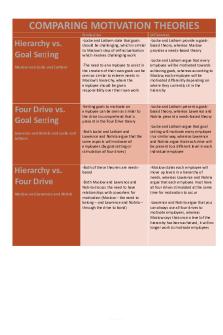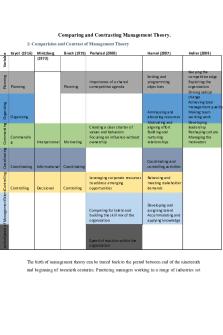Comparing Curriculums PDF

| Title | Comparing Curriculums |
|---|---|
| Author | Kiersten Waller |
| Course | Planning with a Purpose |
| Institution | Rasmussen University |
| Pages | 6 |
| File Size | 57 KB |
| File Type | |
| Total Downloads | 62 |
| Total Views | 176 |
Summary
In a 2-3 page paper written in APA format using proper spelling/grammar, compare and contrast two (2) integrated curriculums. Be sure to include the components below:
Introduction
Describe your first curriculum. Be sure to explain the details and history.
Describe your secon...
Description
1
Module 01 Written Assignments: Comparing Curriculums
Kiersten Waller Rasmussen College EEC3407: Planning with a Purpose Deidra Boodoo 19 February 2021
2 Module 01 Written Assignment: Comparing Curriculum Each childhood setting utilizes different curriculum usage based on what will make children think and explore in different and new and creative ways. When educators decide which curriculum to utilize it is important that the student’s developmental needs and learning experiences are taken under consideration. There are five main curriculum models and approaches when implementing such material in an early childhood program: Project Approach, Creative Curriculum, Reggio Emilia, High Scope Curriculum, and Montessori Curriculum. I will compare the creative curriculum and high scope curriculum model. The Creative curriculum is founded under six fundamental beliefs. The first is that play is valuable for learning. The second is that developing social skills are important. The third is that the teacher’s role is to connect learning with content. The fourth is that parent partnerships are important. The fifth is that all children have the potential to thrive and learn. The sixth is that curriculum and assessment are connected. Furthermore, the curriculum framework is based on five components: how children develop and learn, the learning environment, what children learn, the teacher’s role, and the family’s role. The High Scope Curriculum model is centered on the “plan-do-review” model. Children are expected to plan their activities for the day, do their activities, and then discuss the results with their teachers and peers. Educators are the main supporters in the decisions of the children’s activities. They help them complete their experiences by guiding them to a wide variety of activities and encourages them to express their reviews in multiple skill levels. There are main important features that create the High Scope Curriculum Model. This includes active-learning, adult-child interactions, learning environment, routine, and assessment. Beyond that, the High Scope Model is centered around 58 key experiences a child should engage in which is put into the following categories: creative representation,
3 language and literacy, initiative and social relations, movement, music, classification, seriation, number, space, and time. While both curriculum models are quite different, Creative Curriculum and the High Scope Curriculum have three similarities in common upon further analyzation. The first is that learning is supported through key interest areas of the classroom. The High Scope Curriculum areas in the classroom are clearly designed and labelled. The design of the environment is intended to maximize children’s independent access to learning equipment and areas. In the Creative Curriculum model, teacher’s set-up and maintain interest areas in the classroom that make it possible to for teachers to teach and children to learn. These interest areas include blocks, dramatic play, toys and games, art, library, discovery, sand and water, music and movement, cooking, computers, and outdoors. The second similarity is that the curriculum models are utilized through active-learning and adult-child interactions. In the High Scope Curriculum model, the teachers must use many direct experiences to guide a child’s social, emotional, cognitive, and physical development. This includes allowing children to follow activities they choose with the teacher’s guidance. In the Creative Curriculum model, shows how children learn skills through daily experiences. This is only possible with the way teachers place observations on a variety of instructional strategies to help guide the children’s learning which brings us to our third similarity: observation and assessment being utilized through daily curriculum experiences. In the Creative Curriculum model, teachers observed children through their everyday classroom experiences as aligned by each of the fifty objectives and documenting these experiences to make informed decisions. In the High Scope Model, assessment is carried out through observations using a child observation record, and these observations are used to plan further experiences and share with the parents of the child. After analyzing these similarities, it is also essential that the differences between each curriculum model is made aware. The first is what each curriculum model is based on. The Creative
4 Curriculum model is based on six fundamental beliefs: the value of play, social competence, the role of the teacher, partnerships with families, all children have the potential to thrive and learn, and that curriculum and assessment are connected. The High Scope model is based upon the “plan-do review” process. This means that each child is encouraged to plan how to use their time, do what they planned, and then at the end of each learning day are to review what they learned with their teachers and peers. The second difference is the view and perception of family partnerships. The High Scope model believes that parents and families should be involved after assessments and observations are made, in order to share these decisions and observations with families. For example, in this model, a teacher might have a meeting with a parent after observing behaviors during an activity. In the Creative Curriculum model, the family’s role is placed on high priority in the curriculum framework. A large part of the curriculum is welcoming families, getting to know them, and making them interactive in the child’s learning. For example, in this model a teacher might share activities with parents to extend the child’s learning at home. In planning DAP activities for a group of five-year old’s, the activities will be different for each curriculum model when being implemented, however will still show the characteristics of DAP lessons in representing child development and learning, knowing what is individually appropriate, and knowing what is culturally important. For the creative curriculum model, this curriculum strives on play-based learning, so I would plan a lesson to extend a child’s learning during their play. For instance, if the theme was zoo animals, I might plan an activity for children to pretend to feed zoo animals in the dramatic play area. I would put up a feeding schedule and introduce it to the children. Each child would place a bowl of pom poms in front of each “animal” during feeding times. If using the same theme and age group in the High Scope approach and model, this would look quite different. Each child would plan what they would like to do for that day. Upon what the child is chosen, then activities would be put in place to extend that child’s learning during interactions and active learning. For example, if the child decided they would like
5 to paint. I might encourage that child to paint animals during this time, and then review it with the child later.
6...
Similar Free PDFs

Comparing Curriculums
- 6 Pages

Comparing phylum
- 2 Pages

Gizmo - Comparing Earth Venus
- 4 Pages

Comparing Political Systems
- 37 Pages

Comparing Motivational Theories
- 1 Pages

Reading and comparing key ideas
- 1 Pages
Popular Institutions
- Tinajero National High School - Annex
- Politeknik Caltex Riau
- Yokohama City University
- SGT University
- University of Al-Qadisiyah
- Divine Word College of Vigan
- Techniek College Rotterdam
- Universidade de Santiago
- Universiti Teknologi MARA Cawangan Johor Kampus Pasir Gudang
- Poltekkes Kemenkes Yogyakarta
- Baguio City National High School
- Colegio san marcos
- preparatoria uno
- Centro de Bachillerato Tecnológico Industrial y de Servicios No. 107
- Dalian Maritime University
- Quang Trung Secondary School
- Colegio Tecnológico en Informática
- Corporación Regional de Educación Superior
- Grupo CEDVA
- Dar Al Uloom University
- Centro de Estudios Preuniversitarios de la Universidad Nacional de Ingeniería
- 上智大学
- Aakash International School, Nuna Majara
- San Felipe Neri Catholic School
- Kang Chiao International School - New Taipei City
- Misamis Occidental National High School
- Institución Educativa Escuela Normal Juan Ladrilleros
- Kolehiyo ng Pantukan
- Batanes State College
- Instituto Continental
- Sekolah Menengah Kejuruan Kesehatan Kaltara (Tarakan)
- Colegio de La Inmaculada Concepcion - Cebu









